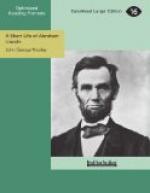The term so accurately described the character of Vallandigham, and the pointed query so touched the hearts of the Union people throughout the land whose favorite “soldier boys” had volunteered to fill the Union armies, that it rendered powerless the crafty criticism of party diatribes. The response of the people of Ohio was emphatic. At the October election Vallandigham was defeated by more than one hundred thousand majority.
In sustaining the arrest of Vallandigham, President Lincoln had acted not only within his constitutional, but also strictly within his legal, authority. In the preceding March, Congress had passed an act legalizing all orders of this character made by the President at any time during the rebellion, and accorded him full indemnity for all searches, seizures, and arrests or imprisonments made under his orders. The act also provided:
“That, during the present rebellion, the President of the United States, whenever in his judgment the public safety may require it, is authorized to suspend the privilege of the writ of habeas corpus in any case, throughout the United States or any part thereof.”
About the middle of September, Mr. Lincoln’s proclamation formally put the law in force, to obviate any hindering or delaying the prompt execution of the draft law.
Though Vallandigham and the Democrats of his type were unable to prevent or even delay the draft, they yet managed to enlist the sympathies and secure the adhesion of many uneducated and unthinking men by means of secret societies, known as “Knights of the Golden Circle,” “The Order of American Knights,” “Order of the Star,” “Sons of Liberty,” and by other equally high-sounding names, which they adopted and discarded in turn, as one after the other was discovered and brought into undesired prominence. The titles and grips and passwords of these secret military organizations, the turgid eloquence of their meetings, and the clandestine drill of their oath-bound members, doubtless exercised quite as much fascination on such followers as their unlawful object of aiding and abetting the Southern cause. The number of men thus enlisted in the work of inducing desertion among Union soldiers, fomenting resistance to the draft, furnishing the Confederates with arms, and conspiring to establish a Northwestern Confederacy in full accord with the South, which formed the ultimate dream of their leaders, is hard to determine. Vallandigham, the real head of the movement, claimed five hundred thousand, and Judge Holt, in an official report, adopted that as being somewhere near the truth, though others counted them at a full million.
The government, cognizant of their existence, and able to produce abundant evidence against the ring-leaders whenever it chose to do so, wisely paid little heed to these dark-lantern proceedings, though, as was perhaps natural, military officers commanding the departments in which they were most numerous were inclined to look upon them more seriously; and Governor Morton of Indiana was much disquieted by their work in his State.




